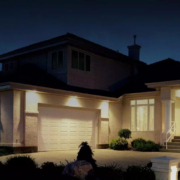Home Security Tips
According to the FBI’s there were over 1 million home burglaries reported in 2015. That’s a rate of one burglary for every 134 homes making home security more important than ever. At the most basic level, making your home more secure is preventing a would-be burglar from entering your home. This can be accomplished by following a few basic rules and by employing security solutions that are effective and realistic.
Securing Exterior Doors
Exterior doors are the most used point of entry for burglars. There are several points of potential weakness on a typical door such as: the handle and lockset, hinges and their mounting screws, strength of the door itself, and the door jamb or frame. Sliding patio doors and French doors present a whole new set of weaknesses. Here are some suggestions on how to make your doors a safer barrier:
- Don’t rely on the spring-latch lock on your door handle. These locks are easy to compromise. Incorporate a sturdy deadbolt lock.
- Install door armor kits on exterior doors to help prevent burglars from taking advantage of the weakest parts of your door. These kits usually include 3” screws to replace short screws that come with door hardware, hefty strike plates for handles and deadbolts, and metal framing to place around the hinge and handle/lock hardware.
- Add auxiliary locks to sliding doors. Options include loop locks, security bars, or a vertical bolt locks.
Security bars are sometimes known as sliding door polls or charlie bars. - Add a security bar to French doors to decrease the likelihood of a kick-in. These bar systems might not be the most attractive, but they make up for their looks with effectiveness.
- A sometimes overlooked detail about French doors, and doors in general, is hinge placement. Ensure that all of your hinge pins are interior-facing to avoid giving burglars easy access without force.
- Add security film to glass doors. This window film prevents glass from being easily broken. Security film is an inexpensive way to help stop an intruder from quickly kicking through a patio door without sacrificing the benefits of having a glass door.
Securing Windows
Windows can be easily secured. There are numerous window security solutions for new and old windows that increase effectiveness at keeping out intruders. If you’re in the market to replace your windows, here are some key suggestions:
- Look for reinforced glass or acrylic windows. Reinforced (tempered or laminated) glass and acrylic (polycarbonate) are much harder to break than traditional glass windows. This can help deter criminals from continuing an intrusion after they attempt to break your windows.
- Multiple panes of glass are better than one large pane. Multiple glass panes provide added strength and durability to repel break-in attempts.
If you’re looking to increase the security of your current windows, these devices can help:
- Add after-market window locks to your built in window locks. These simple gadgets are cheap and very successful at helping to stop a window from being forced open. Depending on your window style, you may need double hung window locks, sliding window locks, or locks for casement windows (sometimes called crank windows.)
- Exterior window bars can be added for additional protection. Many window bars come in decorative designs and can accent the style of your house just as well as they can help protect your windows.
- Security film can be added to windows to decrease the likelihood of break-ins. Thicker film provides the highest level of protection.
Garage Doors
Garage door security is often overlooked by homeowners. While breaking into a garage via the garage door seems unlikely, the truth is it can be done quickly. The worst part about attached garage break-ins is that criminals can shut the garage door behind them and take their time breaking into your home without worrying about being seen. Here are some strategies to help prevent garage break-ins:
- Don’t leave garage door openers in your vehicles. It might seem inconvenient to bring them in each night, but the inconvenience is well worth it by saving you the time and trouble of replacing your belongings.
- Help secure your garage door emergency release to prevent easy intruder access. This can be done by either fastening it with a zip tie (which can be broken by yanking the release cord) or by placing a barrier between the top of the door and the release. Check out a guide for securing your emergency release cord at Family Handyman.
- Use a garage door sensor to remotely alert you when your garage door has opened. Some newer garage door openers have this feature built-in as well as an auto-closing feature that will close your garage door when it has been open for too long.
- Have a dead bolt on the door between your garage and home to prevent further intrusion. It is also a good idea to install a peephole viewer on the door to make it easier to inspect the garage without opening the door.
- Have bright, motion sensing lights in the garage to bring attention to an open garage door.
Make Your Home Look Occupied
Whether you are home or away, it is best to make it look as though someone is home. Having an intruder invade your home is terrifying and traumatic. Here are a few tips that will help make your home look active whether you are there or not:
- Make you home look occupied by having lamps on a timer. Strategically placing lights throughout the house on timers gives the appearance that people are using different rooms.
- Leave a television or radio on at moderate volume. Noise is a great way to make criminals think you’re home. Televisions do a good job of creating light and mimicking activity.
- Don’t close all your curtains and blinds. If you are using timed lights or a television to cast light, it’s good to leave a few open. Open curtains also allow the police (or a helpful neighbor) to see inside your home should the need arise.
Keep Burglars at a Distance
Some of the best burglary prevention techniques are things that you might not even consider to be prevention techniques. These tips are designed to help keep crooks from coming close enough to your home to even attempt to break in.
- Get a dog. Your dog’s bite might not deter a burglar, but its bark might. A barking dog can bring attention to your house and the last thing a burglar wants is attention while they are sneaking into your home.
- Home security system signs are a great way to help stop burglars in their tracks. A home security system means that the perpetrator has only a matter of seconds to burgle your home before the alarm sounds and the police are called. Advertise your alarm system near all entry points to your house.
- A well-lit exterior is a great way to deter burglars. Dusk-to-dawn porchlights or carriage lights take away the veil of darkness from the front of your home. Landscape lighting placed near windows can increase visibility around the rest of your home.
- Parking a car in the driveway is a great way to tell would-be burglars someone is home.
- Keep bushes and shrubs around windows trimmed to avoid creating hiding spots. Additionally, having thorny or spiked plants such as blackberry bushes, holly, or juniper in front of windows can deter criminals from venturing too close.
By taking simple steps you can send the message to a would-be burglar to keep moving.






